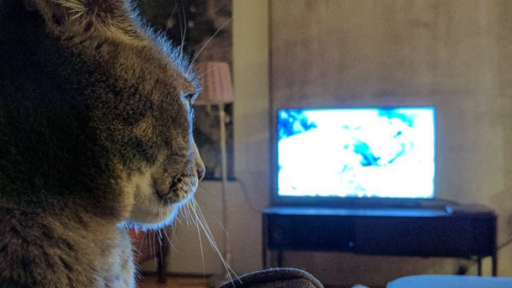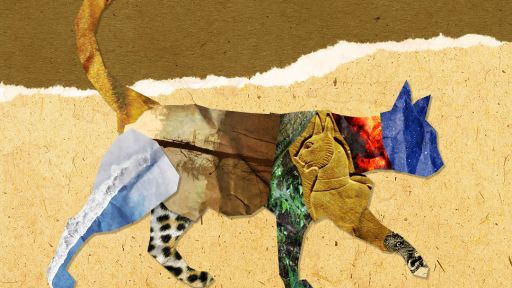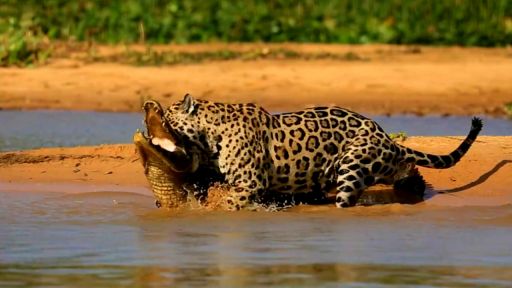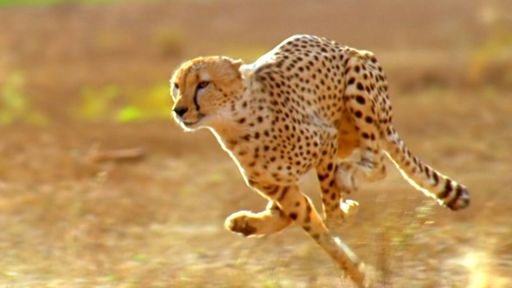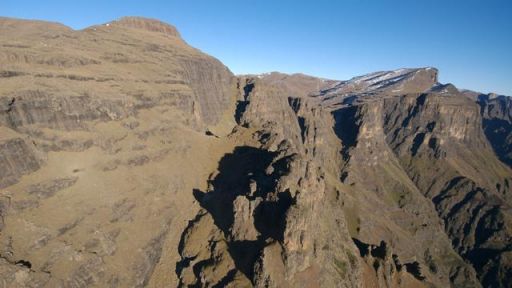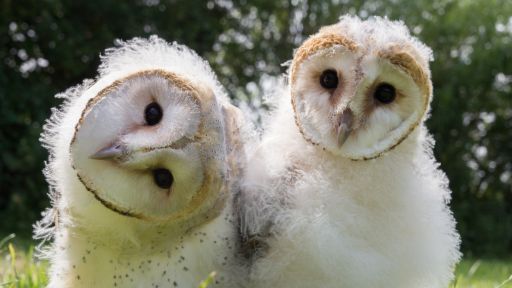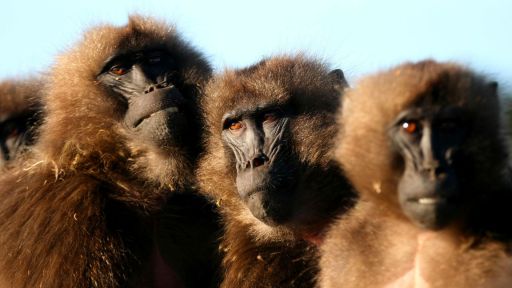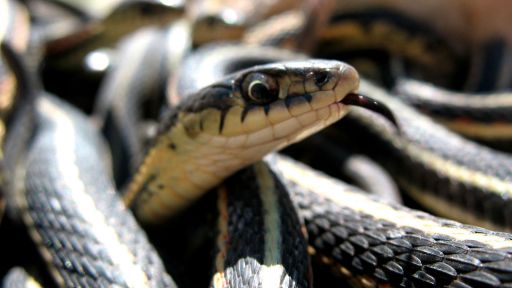TRANSCRIPT
♪♪ NARRATOR: They are the greatest predators since the dinosaurs, the most widespread carnivore on the planet and one may be living in your home.
Cats are a diverse and formidable family of predators.
But what makes a cat a cat?
New research allows us to piece together their story like never before.
Across the planet, 37 different species live in nearly every landscape.
SIKICH: Our last remaining large carnivore in the mountains, surviving next to one of the largest urban areas in the world.
NARRATOR: Even at 20,000 feet above sea level, scientists made a remarkable discovery.
When I saw the photo, I completely surprised.
I did not sleep all night.
[laughs] NARRATOR: This is "The Story Of Cats," [Roar] an 11-million-year evolutionary journey from ancient rainforests and the African savannah and into our homes.
♪♪ ♪♪ NARRATOR: Last time, on "The Story Of Cats," we discovered how the first felines evolved in the tropical forests of Southeast Asia nearly 11 million years ago.
[ Purring ] Agile predators with lethal weapons and honed senses, they established the feline blueprint.
[ Purring ] [ Suspenseful music plays ] Cats spread across Asia and into Africa.
But then, a new world opened up to them... [ Lightning crashes ] [Piercing avian cry] the Americas.
[ Roar ] [ Suspenseful music plays ] Today, there are 13 different species of American cats, from the mighty jaguar to the nimble margay.
[ Suspenseful music climbs ] After their global conquest came the rise of the most successful cat of all... our humble housecat.
[ Snarl ] ♪♪ But the American chapter begins 9 million years ago.
An ice age gripped the planet and sea levels across the world dropped by nearly 200 feet.
[ Suspenseful music plays ] For the first time, a land bridge opened up between Asia and the Americas, across the Bering Strait.
For the cat family, this was their stepping stone into the New World.
Today, one of the descendants of those pioneering American cats still exists.
The Canada lynx.
[ Bird caws ] ♪♪ They're about twice the size of a domestic cat, with really thick fur and long, muscular back legs.
[ Rumbling ] The tufts on their ears channel sound into the eardrum and give them supersensitive hearing.
[ Bird caws ] And a bobtail is less prone to frostbite than a longer tail.
♪♪ Biologist John Squires has been studying Canada lynx for 15 years, tracking them high in the mountains of Colorado.
SQUIRES: The elevation is about 8,000 to 10,000, 12,000 feet.
Cold temperatures, 20, 30 below zero, at times.
Lynx are highly adapted to living in very cold environments.
They're thermally neutral, meaning it's almost like room temperature to a lynx when it's many, many degrees below zero.
That way, they can live energetically in a very cold area and still be comfortable.
[ Static crackles ] ♪♪ NARRATOR: The latest thermal-imaging camera glows white where heat is escaping.
The lynx's fur is so dense, he only loses heat around his eyes and ears.
And a thick scarf of hair around his neck, seen in black, keeps his head extra warm.
[ Grumbling ] But what pushed the Canada lynx to such extremes?
Cats weren't the only predators in North America at that time.
[ Creature howls ] [ Suspenseful music plays ] [ Creature warbles ] As cats were evolving in Asia, early canids, ancestors of wolves and foxes, were rising and spreading across the Americas.
Cats were invading their lands, competing for food and territory.
[ Suspenseful music climbs ] [ Growl ] It was the start of a battle for supremacy for two very different groups of predators.
Who would win out, the pack hunter that chases down prey or the solitary ambush killer?
[ Suspenseful music climbs ] The Canada lynx came up with a clever strategy to avoid competition.
They took refuge high in the mountains, where deep snow meant wolves struggled to hunt.
John Squires knows there's probably lynx around if he spots tracks of their primary prey.
[ Snow crunches ] SQUIRES: These are snowshoe-hare tracks and they have many of the same adaptations the lynx do, in that they have very large paws that allows them to float across the snow surface, just like they have snowshoes, just like I'm wearing.
And lynx have the same adaptations: big, round feet for their weight.
They also have very long legs, light bones.
They almost can fly across the snow surface as they hunt snowshoe hares.
So, really, lynx and snowshoe hares are one of the few animals that really adapted to live in this deep-snow, high-elevation environment.
NARRATOR: Snowshoe hares make up more than 75% of the lynx's diet.
Using their giant feet, hares can bound nearly 30 miles an hour over the surface of the snow.
[ Suspenseful music plays ] Lynx ambush their prey.
They bound across the snow, just like the hares they chase.
♪♪ By adapting the feline blueprint and becoming specialized hunters, Canada lynx were able to colonize areas their canine rivals couldn't reach.
[ Suspenseful chord strikes ] [ Eerie music plays ] But, 7 million years ago, a new group of felines evolved in North America.
Descendants of the leopard that crossed from Asia to America, they, too, pushed their bodies to extremes.
It's thought one cat in this new family drove this antelope to do this.
The American pronghorn is the second-fastest land mammal on the planet, reaching speeds of 50 miles an hour.
But its pace long baffled scientists.
[ Creatures chatter ] The pronghorn's main predators, like coyotes, can't run at anything like this speed.
So, why has the pronghorn evolved to reach such velocity?
♪♪ [Snort] Fossils from a cave in West Virginia show a cheetah-like cat that existed around 3 million years ago.
Long legs; and large nostrils, for better oxygen intake; indicate they sprinted after their prey like modern-day African cheetahs.
[ Bleating ] It's speculated that an arms race between these early cats and the pronghorn may be the reason for the antelope's remarkable speed.
[ Snort ] But, having evolved in America, how did cheetahs end up in Africa?
Over eons, ice ages would come and go... [ Eerie music plays ] and sea levels would fall and rise.
It meant the Bering Land Bridge between Asia and America would open up and close again, allowing animals to disperse and then become isolated.
Cheetahs took advantage of one of these ice-age crossings to work their way into Asia and down into Africa.
Today, they're one of Africa's most iconic cats... and the fastest mammal on the planet.
[ Grumbling ] The lynx and American cheetah were specialists, finely tuned to living and hunting in one particular landscape.
[ Grumbling ] But the cheetah's closest cousin, the mountain lion, or puma, came up with a very different strategy for survival.
It became the Jack-of-all-trades, a generalist capable of living in almost any habitat.
But what was the secret to their success?
Surprisingly, biologists studying mountain lions in the most modern landscape of all, around Los Angeles, are gaining a unique insight.
♪♪ Biologist Jeff Sikich has the job of tracking these top predators on the outskirts of the city.
SIKICH: I'm really fascinated with the urban landscape and how we still have this large carnivore.
It's actually our last remaining large carnivore in the mountains here, surviving next to one of the largest urban areas in the world: Los Angeles.
NARRATOR: As part of his research, Jeff tracks 10 different mountain lions in the Santa Monica mountains.
From the GPS tracks, Jeff can tell that one collared female, called P-39, has remained in the same area for some time.
SIKICH: So we're looking at a cluster of GPS points for P-39 and there's a cluster of points from a little over a day and a half and it looks like she has a kill.
So we're gonna hike into this area to this cluster and see what she killed, and is, hopefully, feeding on.
[ Suspenseful music plays ] NARRATOR: Unlike the highly specialized lynx, mountain lions aren't fussy about what they eat.
They'll take anything, from small mammals to adult deer.
But they share the same winning hunting strategy.
Mountain lions are ambush predators, so they'll actually stalk their prey and get pretty close, sometimes within, ideally, 10 to 15 meters, where they have a burst of speed.
Mountain lions are more sprinters than endurance runners.
[ Insects chirp ] And they'll pounce on the prey, usually from behind.
NARRATOR: This hunting strategy gave American cats the edge over predators, like early wolves, that would chase their prey over long distances.
It was an energy-efficient means of making a kill.
And cats became masters at it.
The GPS tracks lead Jeff to a steep, mountainous area with plenty of scrub.
[ Beeping ] This is perfect puma country, with plenty of places to hide and pounce on prey.
And there's evidence P-39 is still in the vicinity.
SIKICH: This is real fresh urine right here.
We have a track of her.
It has some hair, a very strong odor.
I smell the kill, too, so we're real close.
NARRATOR: For Jeff, this is a giant game of hide-and-seek.
SIKICH: So yeah, it looks like P-39 killed an adult doe mule deer.
She killed this deer around 80 meters from here, drug it down to this spot... covered up the kill, keeping the scent down, hopefully keeps scavengers away.
This is a classic mountain-lion kill site right here that we find in the LA area.
NARRATOR: Mountain lions hide their kills and return to them for several days.
But will our elusive mountain lion return to her hard-won kill?
[Beep] Jeff sets up a surveillance camera and leaves it running overnight.
[ Piercing avian cry ] [ Birds tweet ] The following day, Jeff reviews the footage.
SIKICH: All right, so we have P-39 right here -- [ Purring ] coming back to the kill right at 7:00 pm.
[ Grumble ] NARRATOR: The carcass will last our mountain lion several days.
SIKICH: Yeah, so this is great.
You can see her really tearing at the meat right there, ripping the flesh off the bone.
[ Rumbling ] Her teeth are great for shredding away the flesh.
NARRATOR: Unlike pack animals, like wolves, that must share their spoils, solitary cats get to consume everything they catch.
Jeff's research shows that, even on the outskirts of Los Angeles, mountain lions tend to stick to the brush and hunt large prey, like deer.
This was key to their success.
[ Tranquil tune plays ] It's believed their early ancestors would follow migrating herds over great distances.
3 million years ago, as they spread south, mountain lions and the other American cats reached an impenetrable barrier... [Gulls cry] the ocean.
For millions of years, North and South America had been cut off from each other.
These were turbulent ages.
♪♪ Shifting land masses brought the two continents together, via the Isthmus of Panama.
[ Birds cry ] Cats walked into South America for the first time.
[ Purring ] [ Creature trills ] Much of the southern continent was covered in dense rainforest, teeming with marsupials, distant relatives of the opossum.
Cats were now skillful ambush predators and they set to work on South America's somewhat naive prey.
[ Creatures chatter ] Many marsupials lived high in the trees, beyond the reach of most predators.
For a cat that could climb, there was a great prize.
One cat conquered the canopy like no other... the margay.
[ Cawing ] [ Purr ] The earliest cats, clouded leopards, evolved in the rainforests of Southeast Asia.
Now, in a completely different part of the world, margays regained the tools they needed to climb.
Like feline tightrope walkers, they use their long, maneuverable tails as a counterbalance.
They independently evolved flexible joints in their ankles so they, too, could come down trees headfirst.
[ Birds tweet ] [ Insects chirp ] ♪♪ And, like clouded leopards, margays were nocturnal hunters, catching birds and small mammals in the dark.
♪♪ The reflected layer at the back of their retinas bounces light back like a mirror, so the light-sensitive cells have a second chance to absorb it.
It's what gives margays and our pet cats that unmistakable eye shine and means they can see 6 times better than we can in low light.
♪♪ But when it comes to catching prey, margays don't just use their eyes.
They use their extra-long whiskers.
It's a trick they share with our pet cats.
♪♪ Cats have excellent long-distance vision.
But anything less than 1 foot away appears blurred.
So, when it comes to delivering the deadly bite, they're not using their eyes, but their whiskers.
♪♪ Muscles at the base of the whiskers can move them forward to surround their prey in an instant.
Each of the whiskers works out the orientation of the prey, so the cats know where to deliver the deadly bite.
It's how domestic cats and margays catch prey in total darkness.
[ Creatures caw ] There were other challenges for the pioneering South American cats.
[Thunder crashes] [Singer vocalizes] The climate was warmer and wetter than it is today.
For solitary cats that communicate with each other by leaving scent marks, this was a problem.
Their scent was constantly washed away.
But the margay's closest relative came up with an ingenious plan.
The ocelot became one of the smelliest cats in the world.
[ Thunder rumbles ] To mark territory and advertise for a mate, ocelots produce a pungent odor.
It's so powerful, it can still be sniffed out after a torrential downpour.
[ Thunder rumbles ] It contains pheromones, chemicals packed with sensory information, such as whether a female is in estrus.
Sniffing out these pheromones is how these solitary cats find a mate in the vastness of the rainforest.
And this will be crucial for one young ocelot at a rescue center in Costa Rica when he's released back into the wild.
MILLER: Namu!
NARRATOR: Dexter Lewis Miller -Namu!
-has been looking after Namu, a 1-year-old male ocelot, since he was a kitten.
[ Miller speaking local language ] NARRATOR: And this is Namu.
[ Miller smooching ] [ Namu purring ] Namu.
¿Tienes hambre, ah?
[ Grumble ] ♪♪ NARRATOR: Dexter is preparing the young ocelot for life in the wild.
[Grumbling] -Namu is learning fast.
He's becoming an accomplished hunter.
But Dexter wants to test whether Namu will be able to sniff out a mate in the rainforest.
So he's setting up a bizarre experiment... to test the young ocelot's sense of smell.
MILLER: Today, we're gonna be testing, Estée Lauder, Calvin Klein, and Chanel.
NARRATOR: No one's quite sure why an ocelot would react to certain brands of perfume.
It's the mysterious power of chemistry.
MILLER: Namu!
[ Grumble ] NARRATOR: But which one will Namu go for?
He's not keen on the first one.
[ Purring ] But this one has certainly taken his fancy.
MILLER: The log had the perfume of Estée Lauder.
He like it very much.
NARRATOR: So much so, he doesn't even get to the Chanel.
But, for Dexter, the most important thing is how Namu detects the perfume.
He doesn't just smell it through his nose, as we do.
Namu uses his tongue to flick particles to a special scent detector inside his mouth.
Our pet cats have this, too.
If a tomcat comes across the scent of a female, he'll open his mouth and taste the air.
It's how cats communicate through scent.
[ Grumble ] When Namu is released into the jungle, this supersense should help sniff out the perfect partner.
DEXTER: Namu will use this technique to try to find a love.
[ Rumbling ] Namu!
Namu!
NARRATOR: The ancestors of ocelots and margays were some of the earliest and most successful South American felines.
But cats weren't the only predators to have come down the newly formed isthmus from North to South America.
[ Barking ] ♪♪ Just as in cats, the dog's sense of smell was crucial to their success.
They evolved long, pointed noses that maximize their sensitivity to scent.
It gave dogs a better sense of smell than cats, but there was a compromise.
[Growling] The longer muzzle meant canines didn't have the bite strength of felines.
That gave cats the edge as killers.
One South American cat pushed its bite strength to the limit.
[Rumbling] -The jaguar.
[ Suspenseful music plays ] Size-for-size, it has the most powerful bite of any cat.
A short snout and a unique arrangement of muscles in its jaw give it phenomenal strength.
It can crunch down on prey with a massive 700 pounds of pressure.
But why does it need such awesome bite power?
[ Rumble ] When the jaguar's ancestors first arrived here, around 2 million years ago, vast swaths of the Amazon basin were covered in swamp.
There were rewards for a cat that could swim.
♪♪ Jaguars have been known to paddle hundreds of yards, crossing open water to get to tropical islands.
In captivity, they can dive for more than 30 seconds, even consuming food while they're underwater.
[ Eerie music plays ] With their aquatic skills and powerful bite, jaguars were able to take on prey their canine rivals couldn't tackle.
The caiman, an ancient crocodilian that grows to more than 12 feet long.
Their thick skin is protected by an armor of bony plates.
[ Suspenseful music plays ] For millions of years, caiman had been the apex predator.
♪♪ Then, the hunter became the hunted.
This extraordinary act of predation was filmed by a tourist in Brazil's Pantanal.
It has become an Internet sensation.
It shows what skillful and audacious predators cats can be.
[ Creature chirps ] As they spread across the Americas, it was their hunting prowess that gave them the edge over their canine rivals.
[ Howling ] A recent study of fossil evidence shows cats played a significant role in the extinction of 40 dog species.
[ Growl ] From an evolutionary perspective, at least, cats are better than dogs.
[ Sinister music plays ] For the next 2 million years, cats thrived.
[ Snarl ] Some grew to colossal sizes.
Saber-toothed cats weighing up to 900 pounds were specialized hunters of large prey, like bison and mammoths.
[ Suspenseful music plays ] The mighty American lion, 25 percent bigger than today's African lions, was one of the biggest cats ever to have lived.
[ Grumbling ] [ Rumbling ] ♪♪ Cats out-muscled the competition.
[ Rumbling ] But, 12,000 years ago, disaster struck.
At the end of the last ice age, three quarters of the large mammals in North and South America were wiped out.
[ Snorting ] Exactly what caused this cataclysm remains a mystery to this day, but it's believed a combination of climate change and hunting pressure from early humans drove many big herbivores to extinction.
With nothing to feed on, predators soon followed.
Cats were hit hard.
Some were lucky.
The mountain lion was almost annihilated, but a few individuals found refuge in South America and later recolonized the north.
And the cheetah only avoided extinction because it had escaped to Africa millions of years earlier.
♪♪ Several large felines, including the mighty saber-toothed cats and the American lion, were lost from the landscape forever.
[ Ominous music plays ] [ Feline snuffs ] But cats were on the move once more... making a U-turn out of the Americas, crossing the land bridge back into Asia.
[ Birds tweet ] With large prey now scarce, there were big advantages in being small.
Small cats were inconspicuous and a vast array of smaller prey meant they could vary their diet.
Today, one of the tiniest cats of all is found in the forests of Sri Lanka... the rusty-spotted cat.
It can weigh as little as 2 pounds.
That's less than a third of the weight of the average pet cat.
Biologist Chandika Jayaratne is one of the only people in the world studying them.
NARRATOR: Being small, fast, and well-camouflaged means they're incredibly hard to spot.
NARRATOR: Don't be fooled by their delicate frame.
[Whimsical tune plays] Size-for-size, rusty-spotted cats are said to have a stronger bite than a snow leopard.
[ Snarl ] But it's what they eat that surprised Chandika.
[ Whimsical tune continues ] NARRATOR: Rusty-spotted cats are one of the few species of insect-eating cats.
It's something pet cats do occasionally, too.
In the jungles of Sri Lanka, it's given this tiny terror the edge.
[ Cawing ] By 10,000 years ago, the cat's global conquest was almost complete.
[ Triumphant music plays ] They were found in almost every habitat across Asia, Africa, and North and South America.
♪♪ But then, something happened that would change the story of cats forever.
In an area of the Middle East known as the Fertile Crescent, humans started growing and storing grain for the first time.
And that attracted hoards of hungry mice into our villages.
[ Squeaking ] They had a huge appetite for the grain, and that made them public enemy number one.
But one bold cat came to our rescue: the wildcat.
It stands about knee height and has distinct mackerel stripes still seen in many domestic cats.
♪♪ Different species of wildcat are found from Southern Africa [Ominous music climbs] to Scotland.
All are nimble, nocturnal predators.
[ Triumphant music swells ] This footage, filmed with the latest thermal-imaging camera, shows a wildcat in the Highlands of Scotland.
Like their ancestors, they catch mice and rats, but, tonight, this wildcat is on the hunt for rabbits.
[ Ominous music climbs ] [ Suspenseful music climbs ] Stalking its prey, it uses the same ambushing style as its big-cat cousins.
[ Suspenseful music plays ] [ Eerie music plays ] [ Bleating ] Tonight, the rabbit outruns him.
It was their hunting prowess that first brought cats and humans together.
[ Squeak ] As our grain stores started to provide a plague of mice to hunt, a few brave wildcats came closer and closer to our villages.
It was the tamest cats that caught the most mice and, over time, these wildcats became milder and milder.
[ Purring ] ♪♪ It wasn't until 4,000 years ago and the Ancient Egyptians that we have the first evidence of cats actually living in our homes.
Hieroglyphs show cats with the mackerel stripes of their wildcat cousins hunting birds and vermin amongst the crops.
The Egyptians worshipped cats, and even sacrificed them as gifts for the gods.
Ancient Egypt was the launchpad for domestic cats' global conquest.
Brought onto trading ships as mousers, they started to spread across Europe.
Domestic cats first arrived in America with European settlers a few hundred years ago.
Now, there are only a few islands, and Antarctica, that are not home to domestic cats.
[ Gong crashes ] [ Thunder rumbles ] As domestic cats spread across the world, they started to naturally change and lose their stripey coats.
It was in Southeast Asia, 600 years ago, that a genetic mutation created the first distinct feline breed.
[Purring] The Siamese cat.
[ Purring ] ♪♪ [ Meow ] They have pale bodies and darker extremities.
[ Meowing ] Only the fur on the cooler parts of the cat's body produces any color pigment.
It means their warm bodies are white, but the cooler extremities, like the ears, are black.
The same mutation made their eyes an azure blue.
[ Meow ] [Meow] The naturally occurring Siamese cat began our passion for ever-more exotic-looking felines.
[ Purring ] 200 years ago, -[Meow] we started breeding cats for the features we liked.
♪♪ On today's catwalk, there are more than 40 fantastic-looking felines.
Bengal cats are prized for their exotic coats.
They were originally hybrids of the domestic cat and the wild Asian leopard cat.
[ Purring ] [ Rowr ] The Selkirk Rex looks like he's had a perm.
A genetic mutation caused those curly locks.
♪♪ And, perhaps the oddest of all breeds, the Sphynx, was selectively bred for its baldness.
In some cats, even the whiskers are lost.
[ Purring ] It was in our homes that cats crossed paths with their age-old rivals once more.
[ Panting ] Dogs.
[ Whimsical tune plays ] Now, they weren't just competing for food, but for our attention.
[Bark] -Dogs have been domesticated 3 times longer -[Panting] and we've bred them to help us with really specific tasks.
[ Whine ] [ Baaing ] [ Panting ] [ Barking ] [ Birds tweet ] But the cat's independent nature and their ability to look after themselves made them low-maintenance house pets.
[ Purring ] [ Purring ] Today, there are 3 times more domestic cats than dogs, some 600 million worldwide.
[ Purring ] In the battle for numbers, cats win out, once more.
[ Meow ] But there's a twist in the cat's tale.
Because they've only been living alongside us for a relatively short period of time, they're still very much wild at heart.
[ Lion snarls ] There's one natural trait they're finding hard to shake off: their killer instinct.
In the United States, it's estimated that domestic cats kill more than 20 billion mammals a year.
Most hunters are free-ranging cats, not owned pets.
Dr. John Bradshaw is a world expert on cat domestication.
BRADSHAW: I think the cat is almost something of a paradox.
It's an animal which we domesticated for a very specific reason, which was to hunt for us, and, because of that, we retained its intrinsic wildness all the way through domestication, in a way that we haven't done with any other domestic animal.
NARRATOR: But, now, John believes our demands on the cat are changing.
BRADSHAW: Suddenly, in the last 20 or 30 years, we've decided that we don't want our cats to go hunting all the time.
I suspect that is grudgingly going to be bred out of them over the next few decades or centuries.
The cat will be able to change into an animal which is much more suited to urban living, particularly.
[ Snarling ] NARRATOR: This is the latest chapter in the story of one of nature's most successful predators.
[ Triumphant music plays ] [ Screech ] By tweaking their blueprint, cats have adapted to each new situation they've encountered.
[ Insects chirp ] [ Purring ] Now, to conquer our homes an d our hearts, domestic cats are making the biggest change of all... [ Growl ] from fierce to friend.
♪♪ ♪♪ ♪♪ ♪♪ To learn more about what you've seen on this "Nature" program, visit pbs.org.
♪♪ ♪♪

